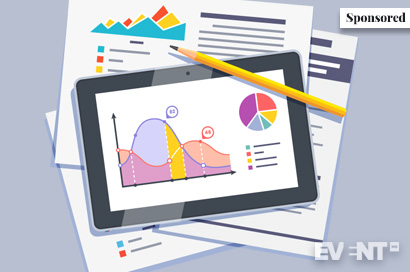This is a sponsored post written by Myriam Dumortier, Brand Manager of Klik. More information about Event Manager Blog’s sponsored posts.
These days, companies track and analyze every detail to determine the ultimate corporate metric – their Return On Investment (ROI). It seems like every day there’s a new innovation to help us better interpret our data.
CRM software is one way that companies measure performance. These marketing automation systems – which measure the success of digital campaigns based on different factors like customer segments – are now an integral part of corporate strategy.
But how does this relate to the meeting industry? What tools do we use to measure an event’s ROI? It’s surprising to see how little progress the industry has made. Sure, it’s standard to measure the number of visitors, dwell time and send out post-event surveys. But where is the event industry’s equivalent of Google Analytics?
Do You Know Your Event Audience?
Eric de Groot and Mike Van der Vijver point out in Into the Heart of Meetings, that the meeting industry has gleaned little or nothing about participants’ behavior during meetings and what principles guide those behaviors. They liken the meetings industry to the car industry, not knowing what people are doing when they sit inside a car.
Even though the book was written in 2013, this still rings true. There are few ways to understand what actually happens during an event. But some solutions are available but still unknown in the industry. These hidden gems can help you better understand participants’ interactions and behavior, and how this behavior affects the event.
The One Goal of (Almost All) Event Planners to Make the Biggest Impact
Every event measures its success according to its own objectives and KPIs. That being said, almost all event organizers have the same goal: to maximize event attendance. But before investing in marketing to attract new attendees, it’s much more efficient to maximize effort by ensuring returning visits. A decent rate of returning visits is a great indicator that your event is successful.
How can you ensure success and a return on experience for attendees and exhibitors? Create a meaningful event!
Knowledge always plays an important role in meetings and the content can be what encourages someone to attend. People don’t only learn from sessions though – they learn by meeting new people and exchanging information too. Attendees get the most out of an event when they can use their new-found knowledge to improve themselves or their day-to-day work lives.
For companies, the more this knowledge gained contributes to their bottom line , the higher their ROI from attending the event will be. This may be shown through more skilled and motivated employees contributing to increased profitability or generating new leads which creates sales and business opportunities.
The Return on the Experience
For an event to have a return on the experience, it needs to be useful for all stakeholders. And for an event to become meaningful, everyone involved needs to optimize their experience by being actively engaged. We need to ensure high-level participation, measure it, and get authentic behavioral data to better understand our audience. Through this process, we can create more meaningful events for both attendees and exhibitors.
Multiplying touchpoints within the event gives you the chance to learn about participants beyond post-event surveys. For example, if you find out that most of your participants stayed at a certain type of booth longer than two minutes and that they collected information more actively than at other locations, you’ll have a better idea of their interests, and you can adjust your offer accordingly. You can also create segments based on behavior, taking you one step closer to an event that will resonate with all kinds of participants.
This establishes a relationship between the event and its guests, generating return visits and event advocates.
Maximize Registrations and Repeat Attendance through Data:
- Use tech to engage the audience, monitor participation and measure responses.
- Ask attendees to set their own actions and goals from the event and follow up at a later date to determine their success rate.
- Analyze traffic and dwell time around the site to identify the areas, exhibitors and content that appealed the most to your audience.
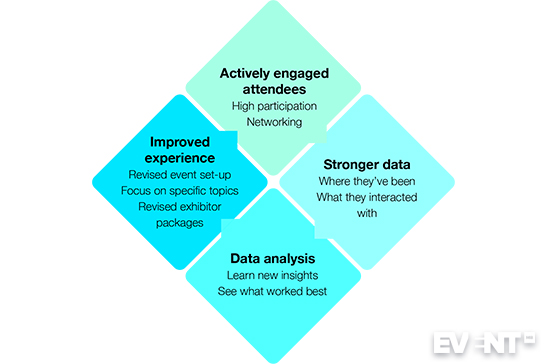
Keep Your Exhibitors and Sponsors Happy (and Keep Them Loyal)
Let’s be honest, exhibitors are an event’s bread and butter.
So, why are we giving them QR code scanners to track success? Most lead retrieval systems on the market are archaic, using technology dating back to 1994.
But it’s 2018! Exhibitors deserve something that can capture what’s actually happening in their booths. Thankfully, there are some revolutionary technology solutions that can help you capture leads naturally and qualify them quickly. Plus, you can learn more about each lead and their natural engagement with the booth. You can also find out more about the booth’s general dynamics, the product’s interaction rate, and more.
The Power of Touchpoints
Let’s say you created an interactive display in your booth, encouraging people to interact with the products they’re interested in while measuring their interest. With more micro-level information on leads and their level of interest, exhibitors can learn more about their target market and how their product is perceived. When you hand out pamphlets to just anyone, you’re missing an opportunity to capture leads. By adding touchpoints where exhibitors exchange information with leads, they can also develop relationships more naturally, based on each lead’s interest. This can help you create more meaningful relationships at your event!
As for exhibitors, ROI isn’t just about the number of leads generated, but also their brand’s awareness and the experience provided by their booth. That’s something they also need to take into account when calculating their ROI. You need to give them a way to measure their ROI other than just the number of leads generated after the event. How many people circulated around their booth and were exposed to the brand? What about the digital brand exposure? Once they have all the data they need, they’ll be more likely to come back and track year-to-year success.
And it goes without saying that this data would help event organizers better negotiate with exhibitors and improve their offer.
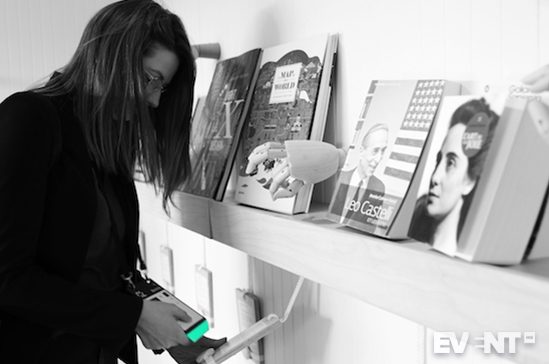

Analyzing Booth Conversion Rates
How often has an exhibitor told you they were unhappy with the number of qualified leads after an event? Did you ever think that it was the exhibitor’s fault? You can chalk up a bad post-event ROI to any number of things: fewer visitors, bad booth position, or a sub-par representative or booth experience. With a technological solution that tracks each booth performance, it is possible to compare factors that had an impact on the booth ROI. For example, Booth A had only one representative as other booths had an average of three representatives at all times or the booth’s representatives stayed in average one hour less onsite than the average.
With specific data like the ratio of leads to booth visits, you can calculate a booth’s specific conversion rate. If it’s low, you can use data to help identify where improvements can be made
Just think of how this information could give your exhibitors and event a boost!
Look after your sponsors and exhibitors:
- Analyze traffic on the showfloor and interactions with different touchpoints around the booth – e.g. downloading information and interaction with a product.
- Calculate the ratio of booth visits to leads to calculate the conversion rate for each exhibitor and analyze the best and worst performers.
- Look at the data, visits, leads and conversions from one year to the next to monitor and drive improvements.
Use Technology and Data to Make Whole Event Improvements
So you’ve created a unique experience for participants and you’re giving your exhibitors cutting-edge technology. But what about the rest of the event?
By investing in a technology solution, you can ensure a return on experience for your participants and exhibitors while tracking all your event’s other features.
It’s important to ensure a certain number of return visits, but there are other event-specific goals, not to mention internal challenges like reduced budgets and more complex events. How can you measure these efforts as a whole?
Technology solutions that can be applied to every aspect of your event, can streamline your logistics by managing your registration system, badges, access control, networking, gamification and more.
This means that you’ll get an overview of your event in real time, giving you the chance to make decisions on the fly. You might even save a few bucks! For example, you can reduce the amount of food being prepared based on the number of people in the cafeteria, or you can send staff to more heavily trafficked areas.
Gaining a Whole Event Perspective
Peter Drucker said it best: “If you can’t measure it, you can’t improve it.” Say you had feedback that your event was dry and lackluster. As a result, the following year, you decide to invest in an innovation lab to inject energy and interest into the event. How can you measure the initiative’s success? What’s the best way to make observations? How do you get a greater number of post-event surveys answered by a bigger percentage of participants?
Alternatively, a solution that can passively track the behavior of each participant, giving you concrete data on your ROI will give a much more scientific and whole event view.
You can use this data as a baseline for upcoming years to ensure that your event is getting better and better. Higher engagement levels, lower wait times, better traffic flow and easier access to sessions are all areas for improvement that need to be measured accurately if you really want to understand your event and see improvements.
Give a Return on Experience:
- Choose a technology solution that analyzes and combines data from a number of sources in real time, rather than offering a snapshot of just one element of your event.
- Instead of relying on data which requires action on behalf of the participant and can be skewed by a small sample size, such as feedback forms, choose a tool that works on passively gathered data.
- Hotspots on the show floor can be used to sell the most popular locations at a premium price for the next event.
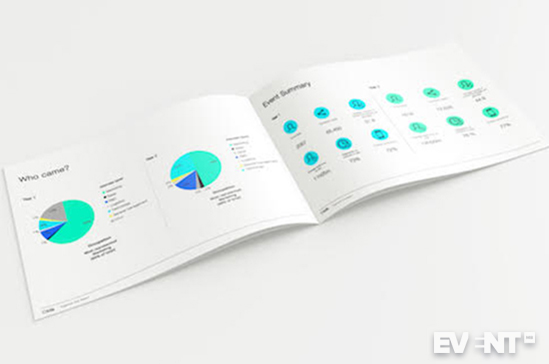

Using Data to Make Better Decisions and Optimize Your Event
Once your event is over, the last thing you want to deal with is a spreadsheet full of code you cannot decipher. Make sure that the solution you choose will continue to support you by providing you with a full report and analysis based on your needs. Data that you cannot understand and analyze is redundant.
Above all, be sure to ask these important questions before your event:
- What do I need to know about my event?
- What do I need to measure each year to optimize my event?
It’s important to establish your needs prior to the event so that your supplier can put everything together thoughtfully.
The goal of reporting is to give you tangible insights. You can create segments based on different types of behavior, understand exhibitor dynamics, see the best and worst performers, and measure session popularity according to time attendance, not sign ups, which is a better indicator of engagement.
Use data to make continuous improvements:
- Analyze what worked best and focus on that to make improvements.
- Personalize the approach to each of your attendees based on their behaviors and history.
- Segment different behaviors to target their interests more accurately with better communications and messaging.
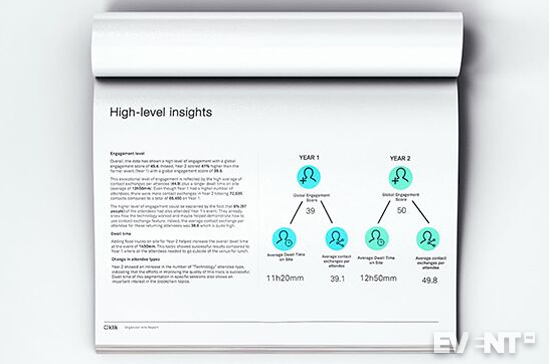

In Conclusion
Since your event is important for your participants, you want them to come back. And since your exhibitors and sponsors will see your ROI, you want to optimize it to maintain loyalty. Above all, you want a great event because you only invest in what works! And how will you make this work? Invest in an optimal technology solution to harvest the data you need and improve your events.

